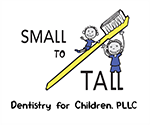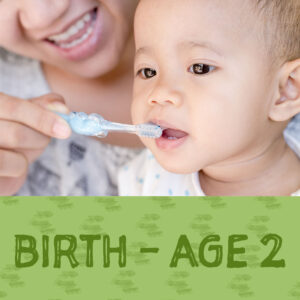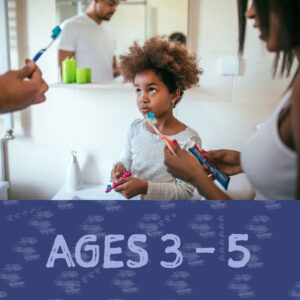Ages 6 – 8
Kids aged 6-8 years are experiencing major mouth transformation. The new teeth seem too large and often fit awkwardly in your child’s mouth. This stage of dental development is affectionately known as the Ugly Duckling Stage. Your child still has to grow an adult sized face for the teeth to look like they belong there!
The major changes your child will encounter are:
- Replacing the 8 front teeth; the 4 upper and the 4 lower baby incisors will be replaced with the adult permanent incisors.
- Growing 4 new molars. These come in behind the baby molars on each side of the mouth (2 up and 2 down). The new adult molars are called: the 6-year-old molars because they tend to show up in the mouth around your child’s 6th birthday.
Your child will be developing the dexterity and skills needed to be able to thoroughly clean their own teeth correctly around this age. It is important to continue to supervise your child when they are brushing their teeth and to limit the amount of toothpaste on the brush – a little goes a long way. Use a small dab of toothpaste with fluoride on the toothbrush, about the size of a small pea is plenty. Your child should brush their teeth at least twice a day with a toothbrush that is the right size for them. Make sure they brush the front and the back of the front teeth, and the tops and sides of the back teeth. Do not forget the sides of the teeth beside the cheeks and the tongue! Make sure that your child spends at least 2 minutes brushing their teeth twice daily. A battery-operated toothbrush with a built-in timer may be helpful so that your child does not to rush tooth brushing. Two minutes brushing is much longer than you think, and is necessary for adequate plaque removal. Make sure your child spits out the excess toothpaste. It is not necessary for your child to rinse after spitting, as the fluoride in the small particles of toothpaste in the mouth will strengthen the enamel and help to prevent cavities from developing.
At this age the front baby teeth start to loosen as the new adult teeth push up under them. Your child should brush gently and thoroughly around the loose baby teeth to keep the gums healthy. The new teeth need to be brushed right from the first day they appear in the mouth. Your child will also be growing new molars behind the baby molars at this age – so encourage them to brush one space further back in anticipation of the new tooth!
Remember to change your child’s toothbrush every 3-6 months when the bristles start to fray. We also recommend changing the toothbrush after an illness to prevent possible re-infection.
Sealants are a durable plastic coating that can be applied to protect the chewing surfaces of the permanent back teeth which grow in around this age. These new molars have deep grooves called pits and fissures. Food and bacteria build up in these narrow grooves putting the child at risk for tooth decay. Why? Even if a child brushes carefully, it is almost impossible to thoroughly clean the deep pits and valleys on these new teeth with a toothbrush. Cavities can therefore develop quickly in these pit and fissures and account for 80-90% of cavities in permanent back teeth.
The good news? Sealants can be placed into and over the pits and fissures, keeping out bacteria and sugars, thus, significantly reducing the risk of tooth decay. Research has shown that sealants reduce cavities by 86% after one year and 58% after four years. And like our fillings, our sealants never contain BPA by-products. Sealants are painless to apply and only require your child to be able to open wide so we can see, clean and dry the tooth before applying.
If you would like to learn more about whether sealants are recommended for your child, please call our office for an appointment.
Flossing is an important part of oral heath care for anyone who has teeth that touch each other. Remember, brushing only removes the plaque on the tops and sides of your child’s teeth, not in between. As your child grows, you may notice that the spaces between their teeth get smaller and that their teeth start touching. As the teeth get closer together kids start getting more cavities. Although flossing is a nuisance, it helps remove all that gunky stuff such as plaque and food that commonly get caught in between teeth. Flossing is a very important part of daily oral health care which helps to prevent cavities.
Flossing tools, such as a pre-threaded flosser or floss holder may be helpful for children who are just learning how to floss, and for parents who want to help their children floss their hard to reach teeth such as those pesky back molars. Flossing gets easier with practice, so it is better to start young so that your child will develop good oral health skills which will last a lifetime!
It is a fact that the risk of undiagnosed and untreated dental problems is far greater than the risk posed by dental X-rays. Please do not hesitate to let us know if you have any questions regarding the recommendations for X-ray images in our office.
We get this question all the time! Parents are often concerned about their child grinding their teeth and the noise can be quite alarming! Many children grind their teeth during sleep and they do it every day. This is very common and is viewed as a harmless sleep habit, in the same way we view sleep talking or restless legs. No treatment is needed for bruxism in the growing child and the good news is, most children outgrow bruxism. The grinding decreases between the ages 6-9 and children tend to stop grinding between ages 9-12 once they lose all of their baby teeth.
In some children the habit may persists into the teen years, and if we detect excessive wear of the teeth a custom mouth guard (night guard) may be indicated. We do not recommend a night guard for young children as it poses a choking hazard and small children rarely cause extreme damage to their teeth from grinding.
Occasionally grinding may be a sign of stress in your child, so if your child just started grinding you may want to check with your pediatric dentist to make sure everything is OK.







